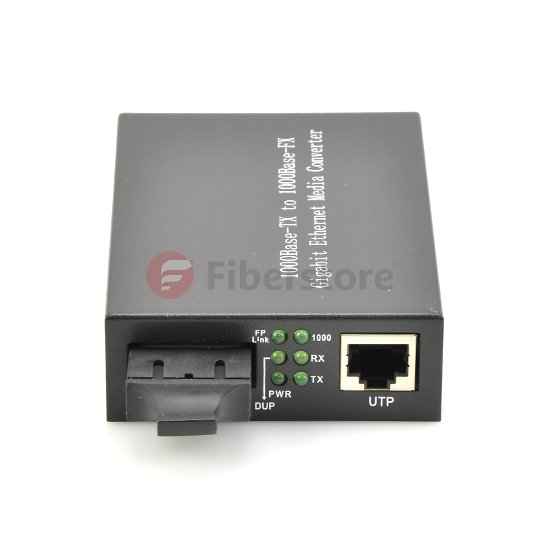Over the years, there has been a growing popularity of Ethernet networks, resulting in the increasing use of Ethernet switches in the network infrastructure. But there is problem that the majority of Ethernet switches on the market today are available only with either 10Base-T or 100Base-TX interfaces (i.e., RJ-45). And on the other hand, in order to meet the needs of longer distance transmission and immunity to electrical interference or eavesdropping/interception, fiber cable has been used on a large scale. Since the entire network is not all twisted pair, the problem of how to interconnect disparate cabling types to the switch must be solved. As a result, media converter, a device which can convert RJ-45 to one of the fiber types in use, has been designed.
What is a Media Converter?
Media converter is a simple networking device that enables you to interconnect networks or network devices with different speeds, operation types, modes and media types. And the most common type usually works as a transceiver, converting the electrical signals in copper unshielded twisted pair (UTP) network cabling to light waves used for fiber optic cabling. It is essential to have the fiber optic connectivity if the distance between two network devices is greater than the copper cabling's transmission distance. Since media converters are IEEE compliant devices, they implement IEEE data encoding rules and Link Integrity Test.

Types of Media Converter
Generally, there are two types of media converter. One type is copper to fiber media converter, another is fiber to fiber media converter. And the illustration of each type will be given as follows.
Copper to fiber media converter - It is a compact device that provides seamless integration of copper and fiber cabling in Enterprise, Government and Service Provider networks. Also, it can be divided into two types, too. They are Ethernet copper to fiber media converter and TDM copper to fiber media converter. Ethernet copper-to-fiber media converter provides connectivity for Ethernet, Fast Ethernet, Gigabit and 10 Gigabit Ethernet devices. Some of it support 10/100 or 10/100/1000 rate switching, enabling the integration of equipment of different data rates and interface types into one seamless network.
As to TDM copper to fiber media converter, the common used types are T1/E1 and T3/E3 converters, providing a reliable and cost-effective method to extend traditional TDM (Time Division Multiplexing) telecom protocols copper connections using fiber optic cabling.
Fiber to fiber media converter - This media converter type can provide connectivity between multimode and single-mode fiber, or between dual fiber and single-fiber. What is more, it can support conversion from one wavelength to another. Fiber to fiber media converter is normally protocol independent and available for Ethernet, and TDM applications.
Benefits of Media Converter
Nowadays, media converter plays an important role in multi-protocol and mixed-media networks. In general, media conversion can deliver the following benefits for your network environment:
Cost Reduction - Compared with the hybrid media switches, the cost of media converters with cost-effective Ethernet switches is much lower. What is more, the two devices can do the same job. This type of media converter solution can cost significantly less than that relies on higher-layer devices such as routers or switches.
Flexibility and Simplification - It is of much flexibility for media converter to combine copper with 850 nm and 1300 nm multimode fiber and 1310 nm and 1550 nm single-mode fiber. In addition, With protocol transparency, it can be applied in anywhere in the local network or remote network whether it's a LAN or the WAN environment.
Ease of Use and High Availability - Configuring and installing redundant solution of media converter is much easier to handle and to manage than higher-layer devices. And it will makes the troubleshooting easier if you add management functions to the media converter.
Since media converter has so many advantages, it can support advanced bridge features – including VLAN, Quality of Service prioritization, Port Access Control and Bandwidth Control – that facilitate the deployment of new data, voice and video to end users. In a word, media converter does more than convert copper-to-fiber and convert between different fiber types. It can also provide all these sophisticated switch capabilities in a small, cost-effective device.
Originally published at http://www.chinacablesbuy.com/basic-knowledge-about-media-converter.html


